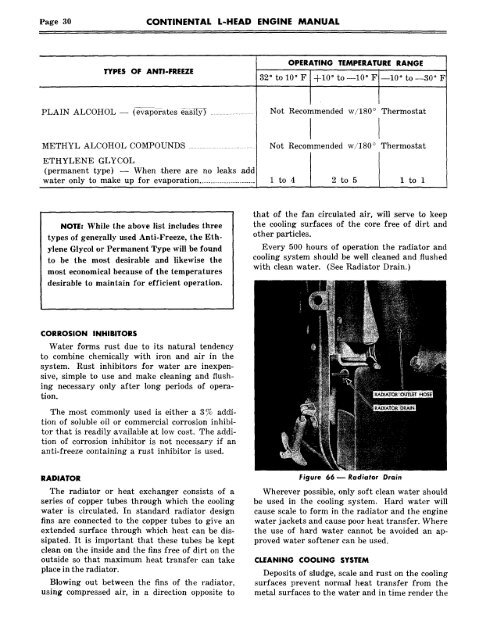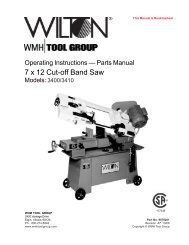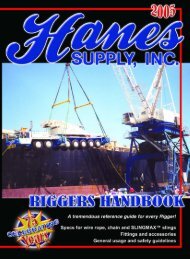Continental L-Head Overhaul Manual - Igor Chudov
Continental L-Head Overhaul Manual - Igor Chudov
Continental L-Head Overhaul Manual - Igor Chudov
Create successful ePaper yourself
Turn your PDF publications into a flip-book with our unique Google optimized e-Paper software.
Page 30 CONTINENTAL L-HEAD ENGINE MANUAL<br />
TYPES OF ANTI-FREEZE<br />
PLAIN ALCOHOL -- (evaporates da~ily)<br />
METHYL ALCOHOL COMPOUNDS ...........................................<br />
ETHYLENE GLYCOL<br />
(permanent type) -- When ,there are no leaks add<br />
water only to make up for evaporation .........................<br />
NOTE: While the above list includes three<br />
types of generally used Anti-Freeze, the Ethylene<br />
Glycol or Permanent Type will be found<br />
to be the most desirable and likewise the<br />
most economical because of the temperatures<br />
desirable to maintain for efficient operation.<br />
CORROSION INHIBITORS<br />
Water forms rust due to its natural tendency<br />
to combine chemically with iron and air in the<br />
system. Rust inhibitors for water are inexpensive,<br />
simple to use and make cleaning and flushing<br />
necessary only after long periods of operation.<br />
The most commonly used is either a 3 % addition<br />
of soluble oil or commercial corrosion inhibitor<br />
that is readily available at low cost. The addition<br />
of corrosion inhibitor is not necessary if an<br />
anti-freeze containing a rust inhibitor is used.<br />
RADIATOR<br />
The radiator or heat exchanger consists of a<br />
series of copper tubes through which the cooling<br />
water is circulated. In standard radiator design<br />
fins are connected to the copper tubes to give an<br />
extended surface through which heat can be dissipated.<br />
It is important that these tubes be kept<br />
clean on the inside and the fins free of dirt on the<br />
outside so that maximum heat transfer can take<br />
place in the radiator.<br />
Blowing out between the fins of the radiator,<br />
using compressed air, in a direction opposite to<br />
OPERATING TEMPERATURE RANGE<br />
32 ° to 10 °F ~-10 °to-10°F<br />
Not ° Recommended w/180<br />
Not ° Recommended w/180<br />
1 to4 2to5<br />
--10 ° to--30 ° F<br />
Thermostat<br />
Thermostat<br />
ltol<br />
that of the fan circulated air, will serve to keep<br />
the cooling surfaces of the core free of dirt and<br />
other particles.<br />
Every 500 hours of operation the radiator and<br />
cooling system should be well cleaned and flushed<br />
with clean water. (See Radiator Drain.)<br />
Figure 66 ~ Radiator Drain<br />
Wherever possible, only soft clean water should<br />
be used in the cooling system. Hard water will<br />
cause scale to form in the radiator and the engine<br />
water jackets and cause poor heat transfer. Where<br />
the use of hard water cannot be avoided an approved<br />
water softener can be used.<br />
CLEANING COOLING SYSTEM<br />
Deposits of sludge, scale and rust on the cooling<br />
surfaces prevent normal heat transfer from the<br />
metal surfaces to the water and in time render the
















